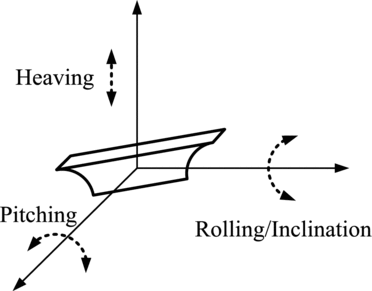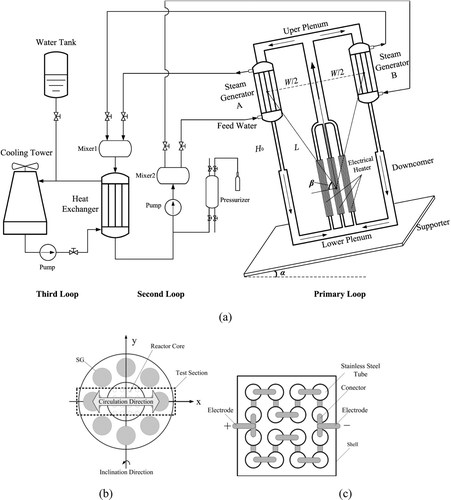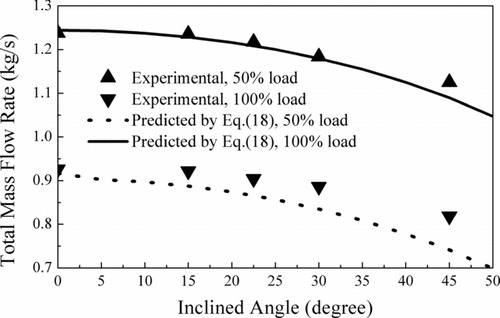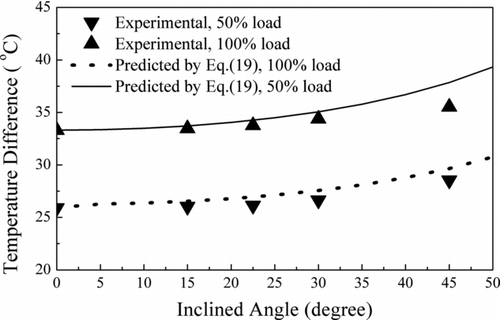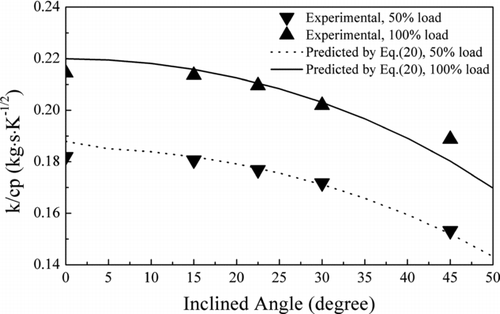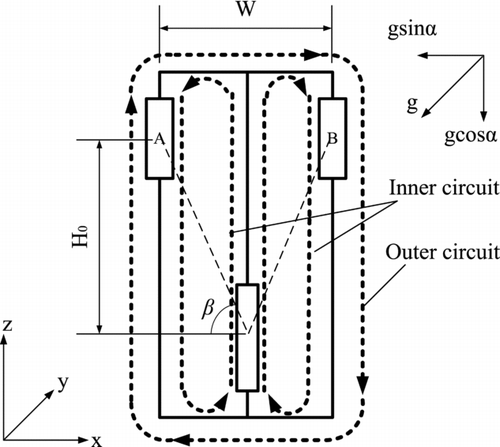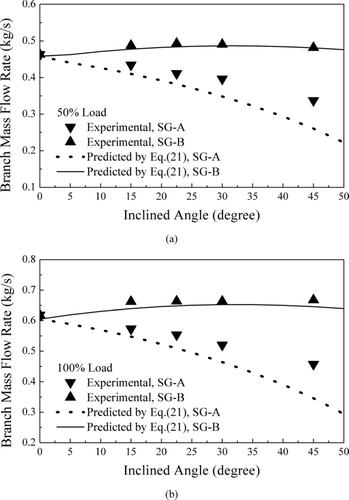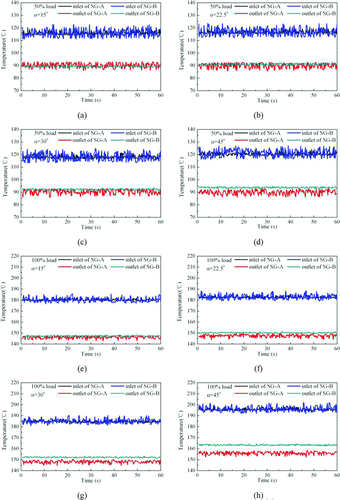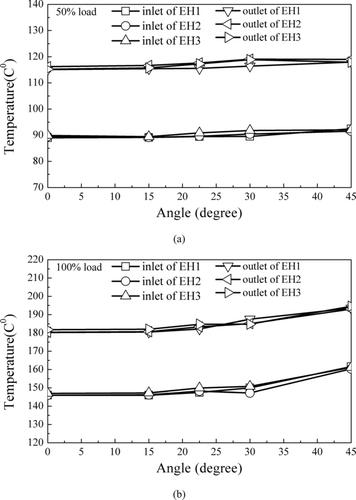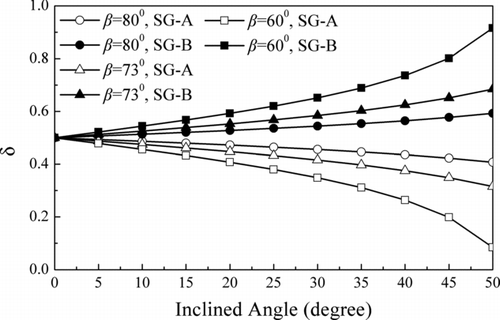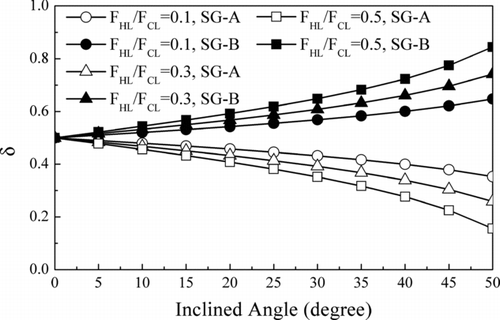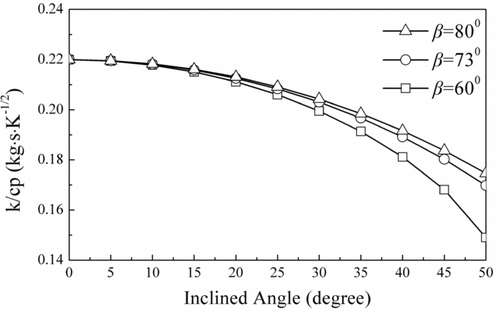Abstract
The natural circulation reactor is widely used in marine environments where thermo-hydraulic performance is heavily affected by the heaving, pitching, and inclining of a ship. This paper theoretically and experimentally investigated steady-state single-phase natural circulation under inclined conditions. Results showed that energy transported by natural circulation was proportional to 1.5 times the power of the temperature difference between the hot leg and the cold leg. Furthermore, a parameter, k, was presented that revealed the comprehensive influence of working fluid properties, resistance characteristics, gravity fields, and loop configurations. k was treated as the criterion for the circulation ability of a loop and it also acted as the basis for evaluating and optimizing different designs. Analysis under the guidance of k was confirmed by a series of experiments performed on a symmetrical two-circuit loop. Both theoretical and experimental results showed that the inclination restrained overall circulation due to the decrease in average altitude difference between the steam generators and the electric heater. The disparity in branch circulations increased with the increase in the inclined angle. A loop design consisting of a large altitude difference and a small width was preferable to confine the influence of inclination. However, if the loop width was too small, it caused a severe reduction in the circulation ability for large angle inclinations.
1. Introduction
Natural circulation is widely used in nuclear systems because of its advantages over the forced flow process, such as the elimination of the pump, improved safety and reliability, and the reduction of maintenance costs [Citation1, Citation2]. Certain ship-mounted integrated-type nuclear power plants also use the natural circulation process for portable desalination [Citation3, Citation4]. However, the thermo-hydraulic characteristics of natural circulation in ship-mounted plants are far more complex than those of land-based plants due to the influence of ship motions such as heaving, rolling, and inclination [Citation5–Citation9] (). In the event of incidents such as collision, sinking, or stranding, the reactor will work under inclined conditions. An understanding of natural circulation behavior under different inclined angles is crucial because inclination causes a reduction in the driving force and also a break in the thermo-hydraulic symmetry of the reactor, where the steam generators annularly surround the core.
Different groups have conducted experimental and numerical studies on specific systems in order to predict the influences of inclination. Iyori et al. [Citation10] used a model of an integrated-type marine reactor to investigate the effect of inclination on single-phase natural circulation. Results showed that the temperature distribution from the steam generator at an inclined attitude was primarily dependent on elevation. Kim et al. [Citation11] performed steady-state natural circulation experiments on the test facility of the System-Integrated Modular Advanced Reactor (SMART) mounted on leaning equipment for inclination. The experiments investigated asymmetric flow patterns in the upper pressure header, steam generator cassettes, and downcomer during feed water isolation and inclination. Kim et al. [Citation12] also developed a computational fluid dynamics (CFD) model and investigated the 3D effects of inclination for the same system. Ishida and Yoritsune [Citation13] investigated the effects of inclination on thermo-hydraulic behavior of a DRX (deep-sea reactor X) using the RETRAN-02/GRAV code. The numerical results showed that ship inclination, even at 60°, induced the core flow to decrease, but the reactor power recovered to initial power levels due to the inherent characteristics of the DRX core. Gao et al. [Citation14] developed a simple mathematical model to predict the circulation characteristics under inclined conditions, but asymmetric effects were not considered in that model. In principle, these results are all restricted to specific systems. The mechanisms of inclination influence are still not comprehensively and quantitatively presented for different systems.
This paper presents research for experiments conducted on natural circulation in a symmetrical two-circuit test loop under inclined angles from 0° to 45°. Also, it presents a derived parameter that revealed the comprehensive influences of the loop properties on natural circulation. These properties included working fluid thermodynamics, flow resistance, loop configurations, gravity, and inclined angles. The natural circulation behavior was predicted based on this parameter and the results corresponded well to the experimental results. Additionally, this paper discusses the variations in the overall circulation ability, disparity in branch circulation, and influence of loop configuration and resistance distribution.
2. Test apparatus
The test loop consisted of three subloops (). The primary loop was the test section, designed as a symmetrical two-circuit loop in order to simulate the symmetrical characteristics of an actual plant (Figure ). Three electric heaters (EHs), located at the shared part of the two circuits, supplied the heat source. Figure shows the arrangement of the heater tubes. Each heater consisted of 16Φ 10 × 1 mm and 1080-mm long stainless steel heating tubes. A DC was applied to the electric heater during operation, with a voltage up to 75 V and a total current of 2000 A. The heat sink was two steam generators (SGs) that were symmetrically installed on the upper part of each circuit. Heat generated by the EH was finally emitted into the environment through the SG, the secondary loop, and the third loop in order to establish the energy balance. The effective altitude difference between the heat source and the heat sink, H 0, was 2100 mm. The distance between the steam generator centers, W, was 1255 mm. The primary loop was installed on a ship motion simulation platform, which inclined about the x-axis and y-axis with maximum angles of 45° and 20°, respectively. The working fluid of the primary loop was demineralized water with a pressure of 4.0 MPa.
The secondary loop consisted of a pump, a heat exchanger, two mixers, and a pressurizer. The coolant for the secondary loop was water-driven by a pump rather than by natural circulation. The mixer and control valves were used to equally set the coolant temperature and flow rates of the two circuits in order to avoid an unbalanced load. The secondary loop was kept at high pressure (4.0 MPa) to prevent the occurrence of two-phase flow due to the simplicity of the equipment. The pressurizer was filled with high-pressure nitrogen gas in order to adjust and maintain the pressure.
The main equipment for the third loop was the cooling tower, through which heat input from the secondary loop was finally emitted into the environment with the coolant circulation.
Ultrasonic flow meters measured the flow of natural circulation at the outlets of each electric heater module and steam generator. The meters had an accuracy of 0.5% over the measured flow rate value and did not bring extra resistance to the circulation. The flow rates of the secondary and third loop were measured by orifice-type flow meters. Temperature was measured by thermocouples with an accuracy of 1% over the temperature range (according to manufacturer specifications). A total of 36 thermocouples were installed at crucial positions throughout the entire test loop, including the inlets and outlets of the EH, the SG, and the heat exchanger.
3. The criterion for natural circulation ability
Despite being well understood, natural circulation is still a very complicated phenomenon due to the coupling of fluid flow and heat transfer. Also, the flow rate of and heat transported by the circulation are affected by a lot of parameters, including the temperature difference between the heat source and the heat sink, fluid properties, flow resistance, loop configurations, and inclined angle. However, we find that the influences of temperature difference can be decoupled from the other parameters, and the comprehensive influences of these parameters can be calculated by a simple integrated expression. Then, based on this result, the natural circulation behavior under inclined condition can be predicted. The derivation is presented below.
For single-phase circulation, the one-dimensional steady-state balance equations can be expressed as:
Energy equation:
Momentum equation:
For small values of ΔT, the density variation can be calculated by
Equations (Equation1) and (Equation4) provide the heat transported by circulation:
By introducing a parameter, k, defined by:
Equation (Equation8) indicates that the heat transported by natural circulation is a function of ΔT and k. These two parameters affected the circulation in different ways. An increase in ΔT results in a larger driving force and mass flow rate; see Equation (Equation7). Also, more heat is carried by per unit mass flow rate, see Equation (Equation1). Parameter k is the function of working fluid properties, flow resistance characteristics, the gravity field, and the loop configuration.
Equation (Equation8) is similar to Newton's law of cooling despite the temperature difference exponent being 3/2 rather than 1. The parameter, k, plays a role similar to the heat transfer coefficient, which represents the heat-carrying ability from a surface by convective heat transfer. The loop with the larger k value has a larger circulation flow rate under certain temperature differences; see Equation (Equation7). It also carries more heat per unit mass flow rate. Furthermore, the loop with the larger k value has less heat resistance between the heat source and the heat sink. Therefore, it is reasonable to regard k as the criterion of the natural circulation ability. As separate influences, the parameters on the right-hand side of Equation (Equation6) are well understood; however, the current literature does not seem to provide a single parameter that comprehensively and quantitatively describes these influences.
The current results are only applicable to the loop with single hot leg and single cold leg. For more complicated circumstances, such as an actual reactor or the loop treated in this paper, which present a loop with single hot leg and multiple cold legs, a similar derivation may be calculated based on continuity, momentum, and energy equations:
Equations (Equation9) to (Equation11) may be solved to obtain the branch flow rate ratios, total mass flow rate, and total heat transported by circulation for two cold leg loops:
The natural circulation ability is derived from Equations (Equation8) and (Equation19):
The branch mass flow rates and heat transported by circulation are derived from Equations (Equation9), (18), and (19):
Equations (Equation14) and (Equation15) calculate δi for the two branch circulation.
The derivation ignored the differences of Δρ, ΔT, and F CL between the two cold legs. These assumptions are reasonable approximations if ΔT is small.
4. Experimental results and discussion
4.1. Effect of inclination on the overall circulation
The decrease in the overall circulation ability under inclined conditions is one of the major concerns for the design of marine reactors. This problem was studied in this paper by conducting a series of experiments under inclined angles of 0°, 15°, 22.5°, 30°, and 45°. Power input from the EH controlled the load from 50% to 100%. The flow rates of the secondary and third loop were kept constant during the experiments. The testing was conducted over 2 hours for each inclined angle in order to obtain a steady state.
The volume flow rate of each steam generator outlet was recorded. The total mass flow rate was obtained by multiplying the density computed by the local pressure and temperature (). Equation (Equation18) predicted a value that corresponded well to the experimental results. The results showed that an increase in the inclined angle gradually weakened the circulation. An inclined angle of 45° had a mass flow rate approximately 10% less than an inclined angle of 0°. The average temperature difference, ![]() , between the hot leg and the cold leg increased as the inclined angle increased (). Here,
, between the hot leg and the cold leg increased as the inclined angle increased (). Here, ![]() is defined by
is defined by
Both the flow rate decrease and the temperature difference increase indicated that the circulation ability was inhibited when the inclined angle was increased. The variation trend of parameter k also validated this (). The gradual decrease in k was caused by the reduction in the average altitude difference, ![]() , which is calculated by
, which is calculated by
Equation (Equation24) showed that ![]() always decreased with the increase in α, although the altitude difference of the right branch circulation may increase ().
always decreased with the increase in α, although the altitude difference of the right branch circulation may increase ().
4.2. Effect of inclination on the branch circulation
Asymmetry of the SG load may cause variations in steam properties and mechanical problems. However, the altitude difference between the cold legs occurs under inclined conditions and leads to a disparity in the circulation ability. This mechanism is illustrated as follows.
For convenience, this problem is analyzed in the frame attached to the test section (). The gravity direction is separate from the z-axis due to inclination. The components of gravity are gx = g·sin α and gz = g·cos α for the x- and z-axis, respectively. The driving force integral is positive along the three circuits (two inner circuits and one outer circuit) under the action of the gravity field. Figure represents this with dotted lines. The interactions between the three “force circuits” form the actual driving forces. As a result, for the branch circulation, the driving force is calculated by
For the left branch circulation, the outer and inner force circuit are opposite in direction and inhibit the circulation. Whereas for the right cold leg, the outer and inner circuit have the same direction and consequently the circulation ability is enhanced. The branch circulation disparity occurs for this reason.
As analyzed above, the right circuit was always stronger than the left. The flow rate of the right circuit increased by approximately 2% when α = 45° (compared with α = 0°), while the flow rate of the left circuit decreased by 26%, as shown in .
shows the inlet and outlet temperatures of the SGs. The inlet temperature of each SG was identical due to full mixing in the pipeline at the EH outlet and upper plenum. Both the inlet and the outlet temperature of the SG increased as the inclined angle increased. The inlet temperature was 4°C higher at 50% load and 15°C higher at 100% load under the condition of α = 45° compared with α = 0°. The SG outlet temperatures also increased with the increase in the inclination angle but in an out-phase mode; i.e., the increase in SG-B was larger than that in SG-A. The difference between the outlet temperatures of the two SGs were approximately 4°C at 50% load and 8°C at 100% load under the condition of α = 45°.
The inlet and outlet temperatures of the EH are shown in . The inlet temperature difference between the modules was negligible because the branch circuit fluids were sufficiently mixed in the lower plenum. Also, the outlet temperature difference between the modules was small. This means that inclination did not cause disparity in heat transfer and flow between the electrical modules.
4.3. The effect of loop configuration
The previous analysis showed that inclination caused the decrease in the overall circulation ability and a disparity in branch circulation abilities. Optimizing the configuration of the loop may reduce these unwanted effects.
In order to reduce the disparity in different branch circulation abilities, the outer force circuit (Figure ) should be inhibited, while the inner force circuit should be enhanced. The ratio of the two driving forces is
Equation (Equation27) shows that an increase in β reduced the relative importance of the outer circuit driving force and then reduced the disparity in the branch circulation abilities. Equations (Equation14) and (Equation15) calculated the mass flow rate ratio, δ, of the cold leg under different values of β (). The difference between the mass flow rates of the two cold legs rapidly increased with the increase in the inclined angle α for small values of β. This indicates that in order to control the influence of inclination, a long and thin reactor core is a better loop configuration for a reactor design.
The ratio between F HL and F CL in Equations (Equation14) and (Equation15) also affected the magnitude of the disparity in the branch circulation. The mass flow rate ratio, δ, was calculated for the same β value with different F HL/F CL values (). The disparity reduced with the decrease in F HL/F CL. Therefore, by the definitions of F HL and F CL provided in Equations (Equation12) and (Equation13), respectively, it is favorable to decrease the flow resistance coefficient, f, of the hot leg (or increase f of the cold leg) as well as increase the cross-section area of the flow channel, A, of the hot leg (or decrease A of the cold leg).
Equation (Equation20) calculated the overall circulation abilities of loops with fixed H 0 values but different β values (). The circulation ability of the smaller β loop was lower than the larger β loop. This trend became more noticeable as the inclined angle increased. Although this analysis showed that a large value of β was helpful in reducing disparity in the branch circulation and alleviating a decrease in the overall circulation ability, β cannot be extended to angles near 90°. The SG-A already has an elevation lower than the EH when α > β. As a result, natural circulation in the left side is prevented. Therefore, the circulation will only occur in the right circuit. Under this condition, the altitude difference will be
Equation (Equation28) indicates that for certain values of α (α > β, and α + β > 90°), ![]() decreases with the increase in β. An extreme is reached with the condition α = 90°, when β → 90° (W → 0),
decreases with the increase in β. An extreme is reached with the condition α = 90°, when β → 90° (W → 0), ![]() → 0. Hence, if the width of the loop W is too small, the circulation cannot be set up under large inclined angle because of the loss of driven head. That is dangerous to the reactor. Therefore, W should be designed to be larger than a safe value W
min, in preventing sever reduction in the circulation ability of the reactor.
→ 0. Hence, if the width of the loop W is too small, the circulation cannot be set up under large inclined angle because of the loss of driven head. That is dangerous to the reactor. Therefore, W should be designed to be larger than a safe value W
min, in preventing sever reduction in the circulation ability of the reactor.
5. Conclusion
This paper theoretically and experimentally investigated steady-state single-phase natural circulation under inclined conditions. The conclusions are as follows:
| 1. | Mass and heat transported by natural circulation are proportional to (ΔT)1/2 and (ΔT)3/2, respectively, where ΔT represents the temperature difference between the reactor core and the SGs. The heat transported by natural circulation is also proportional to a parameter, k, which is the function of working fluid properties, flow resistance characteristics, the gravity field, loop configuration, and inclination angle. The value of k determines the mass flow rate and ΔT for a specific heat load. Therefore, k represents the natural circulation ability of a loop and it also acts as the basis for evaluating the performance of loops and for optimizing different designs. | ||||
| 2. | Both theoretical and experimental results showed that under inclined conditions, the circulation ability was inhibited – the total mass flow rate decreased and ΔT increased. This was caused by the decrease in the average effective altitude. Furthermore, the driving force along the outer circuit of the loop had an opposite effect on the branch circulation and caused disparity in the branch mass flow rates. | ||||
| 3. | An increase in loop angle β (a reduction in width W) reduced the disparity in branch circulation and alleviated the decrease in the overall circulation ability. However, β should be maintained within a safe range to prevent a severe reduction in the circulation ability when large inclined angles occur. Furthermore, a decrease in the value of F HL/F CL was also helpful in reducing the branch circulation disparity. | ||||
Nomenclature
| A: | = |
cross section area [m2] |
| cp : | = |
specific heat capacity [J/(kg·K)] |
| g: | = |
gravity [m/s2] |
| H: | = |
altitude [m] |
| k: | = |
natural circulation ability [W·K−3/2] |
| m: | = |
mass flow rate [kg/s] |
| N: | = |
cold leg number |
| Nc: | = |
loop component number |
| f: | = |
resistance coefficient |
| T: | = |
temperature [°C] |
| W: | = |
loop width [m] |
Greek letters
| α: | = |
inclined angle [degree] |
| β: | = |
configuration angle [degree]; |
| γ: | = |
thermal expansion coefficient [K−1]; |
| δ: | = |
mass flow rate ratio |
| ρ: | = |
density [kg/m3] |
| ϕ: | = |
driving force ratio |
Acknowledgements
Project 11072131 acknowledges the support of the National Natural Science Foundation of China and Project 2010Z02275 of Tsinghua University, Beijing, China.
References
- International Atomic Energy Agency (IAEA) . 2005 . Natural circulation in water cooled nuclear power plants , Vienna , , Austria : IAEA . IAEA-TECDOC-1474).
- International Atomic Energy Agency (IAEA) . 2009 . Passive safety systems and natural circulation in water cooled nuclear power plants (IAEA-TECDOC-1624) , Vienna , , Austria : IAEA .
- Humphries , J R and Davies , K A . 1998 . Floating desalination/co-generation system using the KLT–40 reactor and Canadian RO desalination technology . Proceedings of the Advisory Group Meeting, IAEA-TECDOC , 1172 : 41 – 52 . Jul 20–24; Vienna. Vienna (Austria): International Atomic Energy Agency; 1998
- Panov , Y K , Polunichev , V I and Zverev , K V . 1997 . Nuclear floating power desalination complexes . Advisory Group Meeting on operational modes of nuclear desalination plants (IAEA-TECDOC) , 1056 : 93 – 104 . Nov 3–5; Vienna. Vienna (Austria): International Atomic Energy Agency; 1997
- Murata , H , Sawada , K and Kobayashi , M . 2000 . Experimental investigation of natural convection in a core of a marine reactor in rolling motion . JNucl Sci Technol. , 37 : 509 – 517 . doi: 10.1080/18811248.2000.9714924
- Pendyala , B , Jayanti , S and Balakrishnan , A R . 2008 . Convective heat transfer in single-phase flow in a vertical tube subjected to axial low frequency oscillations . Heat Mass Transfer , 44 : 857 – 864 . doi: 10.1007/s00231-007-0302-3
- Tan , S C , Su , G H and Gao , P Z . 2009 . Experimental and theoretical study on single-phase natural circulation flow and heat transfer under rolling motion condition . Appl Therm Eng. , 29 : 3160 – 3168 . doi: 10.1016/j.applthermaleng.2009.04.019
- Jian , M , Li , L J , Huang , Y P , Huang , J and Wang , Y L . 2011 . Progress in investigations on thermo-hydraulic characteristics of ship nuclear reactors under ocean conditions . Nucl Power Eng China , 32 : 91 – 96 .
- Yan , B H , Gu , H Y and Yu , L . 2011 . The flow and heat transfer characteristics of turbulent flow in typical rod bundles in ocean environment . Prog Nucl Energ , 53 : 487 – 498 . doi: 10.1016/j.pnucene.2011.02.010
- Iyori , I , Aya , I , Murata , H , Kobayashi , M and Nariai , H . 1987 . Natural circulation of integrated-type marine reactor at inclined attitude . Nucl Eng Des. , 99 : 423 – 430 . doi: 10.1016/0029-5493(87)90138-5
- Kim , J H , Kim , T W , Lee , S M and Park , G C . 2001 . Study on the natural circulation characteristics of the integral type reactor for vertical and inclined conditions . Nucl Eng Des. , 207 : 21 – 31 . doi: 10.1016/S0029-5493(00)00417-9
- Kim , T W , Park , G C and Kim , J H . 2001 . Numerical study on the natural circulation characteristics in an integral type marine reactor for inclined conditions . J Korean Nucl Soc , 33 : 397 – 408 .
- Ishida , T and Yoritsune , T . 2002 . Effects of ship motion on natural circulation of deep sea research reactor DRX . Nucl Eng Des. , 215 : 1 – 67 . doi: 10.1016/S0029-5493(02)00041-9
- Gao , P Z , Pang , F G , Liu , S Y and Peng , M J . 1997 . Effects of listing upon forced circulation and natural circulation . Chinese J Nucl Sci Eng. , 17 : 179 – 183 .
